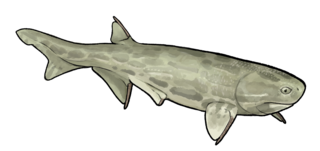
Orthacanthus is an extinct genus of fresh-water xenacanthiform cartilaginous fish, named by Louis Agassiz in 1843, ranging from the Upper Carboniferous into the Lower Permian. Orthacanthus had a nektobenthic life habitat, with a carnivorous diet. Multiple authors have also discovered evidence of cannibalism in the diet of Orthacanthus and of "filial cannibalism" where adult Orthacanthus preyed upon juvenile Orthacanthus. Synonyms of the genus Orthacanthus are Dittodus Owen, 1867, Didymodus Cope, 1883, Diplodus Agassiz, 1843, Chilodus Giebel, 1848.

Xenacanthus is an extinct genus of xenacanth cartilaginous fish. It lived in freshwater environments, and fossils of various species have been found worldwide.

Xenacanthida is an order or superorder of extinct shark-like chondrichthyans known from the Carboniferous to Triassic. They were native to freshwater, marginal marine and shallow marine habitats. Some xenacanths may have grown to lengths of 5 m (16 ft). Most xenacanths died out at the end of the Permian in the End-Permian Mass Extinction, with only a few forms surviving into the Triassic.

Haptodus is an extinct genus of basal sphenacodonts, a member of the clade that includes therapsids and hence, mammals. It was at least 1.5 metres (5 ft) in length. It lived in present-day France during the Early Permian. It was a medium-sized predator, feeding on insects and small vertebrates.

Acanthodes is an extinct genus of acanthodian fish. Species have been found in Europe, North America, and Asia, spanning the Early Carboniferous to the Early Permian, making it one of the youngest known acanthodian genera.

Petalodus is an extinct genus of cartilaginous fish from the Pennsylvanian to the Permian, known from subtriangular to rhomboidal teeth. The genus was named by Richard Owen in 1840 and the type species is Petalodus hastingsii. The only dubious species within this genus is P. securiger.

Pantelosaurus is an extinct genus of basal sphenacodonts known from the Early Permian period of Saxony, Germany. It contains a single species, Pantelosaurus saxonicus.

Fadenia is an extinct genus of eugeneodontid holocephalian chondrichthyan from the Carboniferous Period of Missouri, the Permian period of Greenland, and the Early Triassic epoch of British Columbia, Canada.

Parahelicoprion is an extinct genus of shark-like cartilaginous fish that lived during the Early Permian. Two species are known ; P. clerci from Arta Beds of the Ural Mountains of Russia, and P. mariosuarezi from the Copacabana Formation of Bolivia. Members of the genus possessed a row of large tooth crowns on the midline of the lower jaw, known as a tooth whorl. The characteristics of this whorl are unique to fishes of the order Eugeneodontida, and more specifically the family Helicoprionidae to which Parahelicoprion belongs. The genus name refers to Helicoprion, another eugeneodont from the Ural Mountains that bore a similar midline tooth arrangement.

Symmorium is an extinct symmoriiform cartilaginous fish from the Devonian and Carboniferous of the United States (Illinois) and Russia. The type species, Symmorium reniforme, was named by Edward Drinker Cope in 1893, with other species assigned to the genus having since been reclassified into other genera such as Petalodus. Symmorium bears close similarity in size and appearance to Stethacanthus but lacks the "spine-brush complex" in place of the first dorsal fin. Some paleontologists think that the two forms represented the males and females of related species, while other scientists think they were distinct genera.

The Eugeneodontida, sometimes also called Eugeneodontiformes, is an extinct and poorly known order of cartilaginous fishes. They possessed "tooth-whorls" on the symphysis of either the lower or both jaws and pectoral fins supported by long radials. They probably lacked pelvic fins and anal fins. The palatoquadrate was either fused to the skull or reduced. Now determined to be within the Holocephali, their closest living relatives are chimaeras. The eugeneodonts are named after paleontologist Eugene S. Richardson, Jr. The group first appeared in the fossil record during the late Mississippian (Serpukhovian). The youngest eugeneodonts are known from the Early Triassic. The geologically youngest fossils of the group are known from the Sulphur Mountain Formation, Vardebukta Formation and Wordie Creek Formation (Greenland).
Macromerion is an extinct genus of non-mammalian synapsids, specifically Pelycosaurs, in the family Sphenacodontidae from Late Carboniferous deposits in the Czech Republic. It was named as a species of Labyrinthodon in 1875 and as its own genus in 1879.
Saar–Nahe Basin is a molasse basin in southwest Germany. The basin is located south of the Hunsrück mountains between the rivers Nahe and the Saar. The aggregation of sediments in the basin started in the late Carboniferous and Early Permian as part of the Variscan orogeny.
Altenglanerpeton is an extinct genus of microsaur tetrapod from the Late Carboniferous or Early Permian of Germany. Altenglanerpeton was named in 2012 after the Altenglan Formation in which it was found. The type and only species is A. schroederi.

Cutleria is an extinct genus of basal sphenacodontids or derived stem-sphenacodontoid known from the Early Permian period of Colorado, United States. It contains a single species, Cutleria wilmarthi.

The Cleveland Shale, also referred to as the Cleveland Member of the Ohio Shale, is a Late Devonian (Famennian) shale geologic formation in the eastern United States.

Hopleacanthus is a Permian genus of shark from the Kupferschiefer of Germany.
Adamantina is an extinct genus of jalodont chondrichthyan from the Carboniferous and Permian periods. It is known mainly from isolated teeth and scales. It contains two species, A. foliacea and A. benedictae. The type species, A. benedictae, is known from the Wuchiapingian of east Greenland and the Roadian of the Kanin Peninsula, Russia. A. foliacea is known from the late Tournaisian, late Artinskian, and the early Asselian of Russia and the late Kasimovian of Iowa, United States. There is also a likely occurrence in the upper Pennsylvanian of Brazil.

Romerodus is an extinct genus of cartilaginous fish in the family Caseodontidae. While it and the rest of its family were historically considered elasmobranchs related to sharks and rays, they are now regarded as holocephalans, a diverse subclass which is today only represented by chimaeras. Romerodus is known from the Carboniferous and possibly Permian periods of North America, and the only named species, R. orodontus, was discovered in organic shale deposits in the U.S. state of Nebraska. It is one of few members of its order, the Eugeneodontida, that is known from multiple complete, well preserved body fossils, and is thus an important taxon for understanding the anatomy and ecology of less well preserved eugeneodonts such as Helicoprion. The genus name honors paleontologist Alfred Romer.
Gansuselache is a genus of extinct elasmobranch in the order Hybodontiformes, comprising one species, Gansuselache tungshengi (monotypy) from Gansu Province, China. It is known from Fangshankou Formation, which previously interpreted as Permian in age, but reinterpreted as the Early Triassic in later study. A tooth remain tentatively assigned to this genus is also known from Late Permian strata of Poland.



















